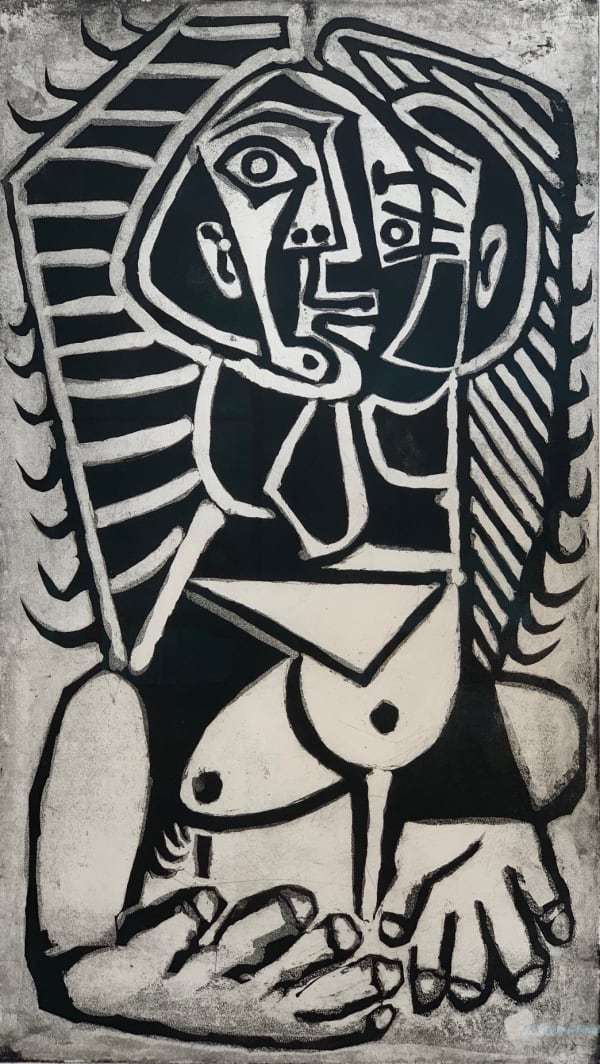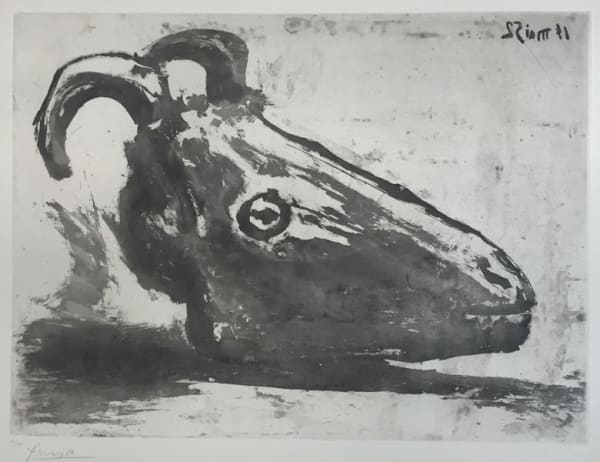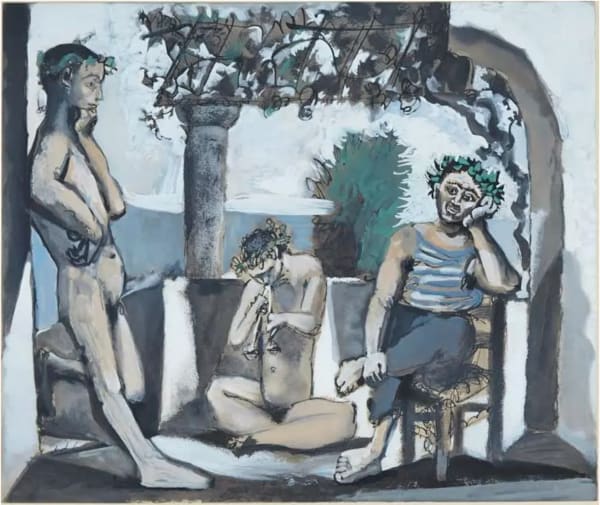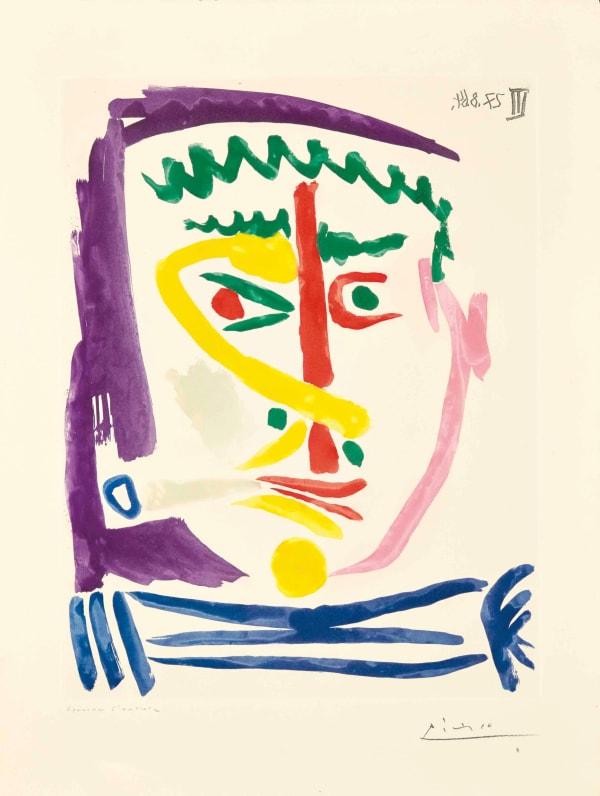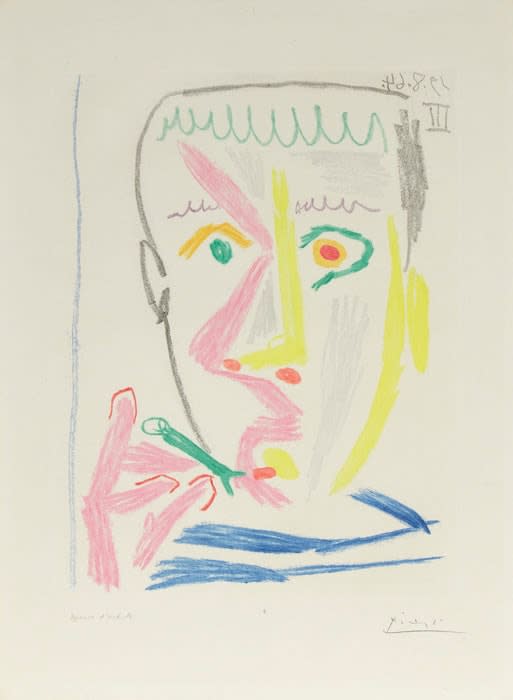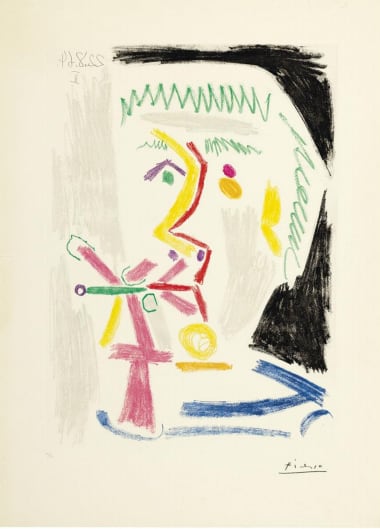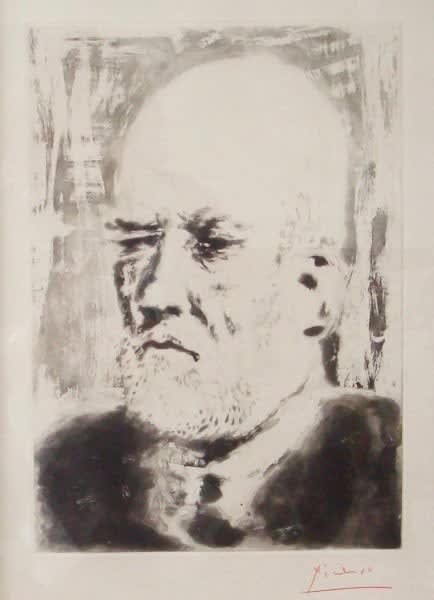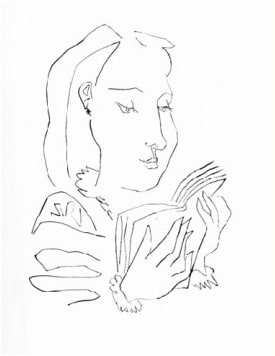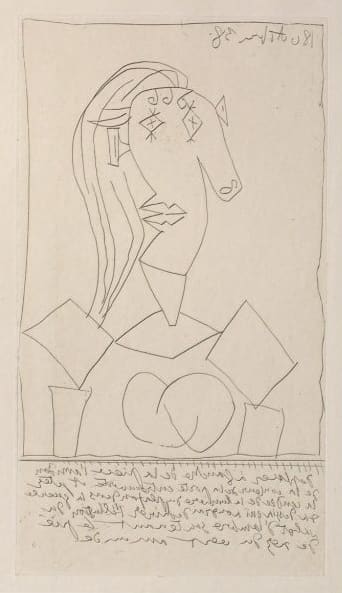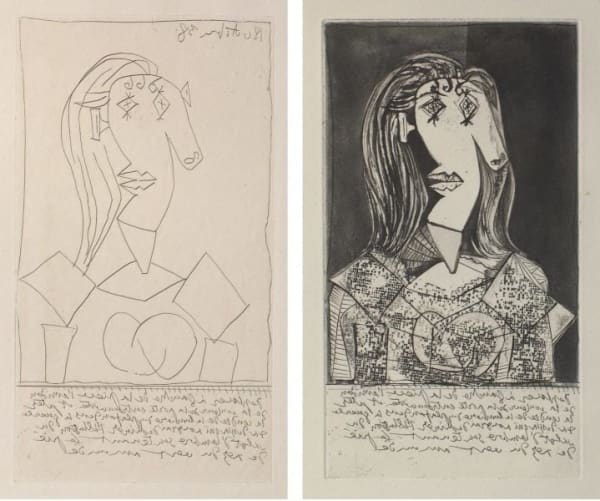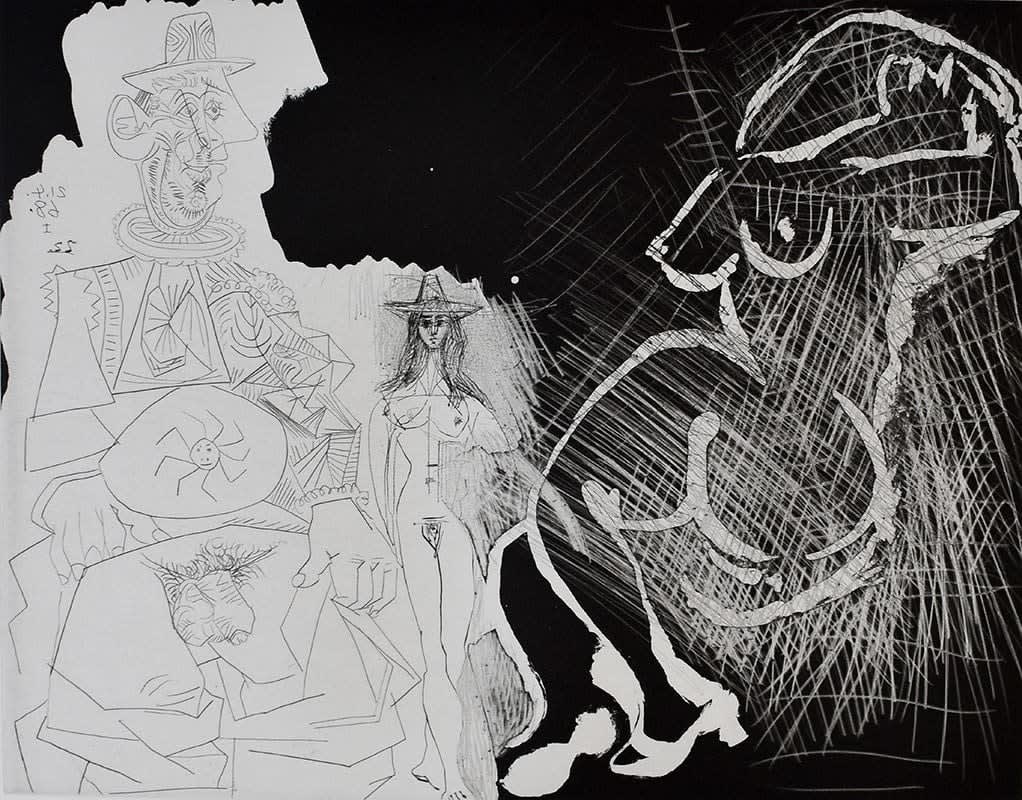
Pablo Picasso
This 1968 print, Caricature of General de Gaulle and Two Women (Caricature du général de Gaulle et deux femmes), from Picasso’s monumental Series 347, exemplifies his late mastery of intaglio printmaking and his irreverent, satirical approach to politics, sexuality, and power. Executed as an original drypoint and aquatint with scraper on wove paper, hand-signed and numbered, the work blends caricature, eroticism, and social commentary into one of the most provocative series of his career.
Picasso’s Series 347 (created in just seven months in 1968) represents one of the most astonishing bursts of creativity in 20th-century printmaking. The technical diversity of the series is extraordinary, and this work is a prime example of his experimentation. Drypoint provides sharply incised lines with a velvety burr, aquatint introduces tonal depth and atmosphere, and the scraper technique allows him to erase or soften areas, creating ghostly textures.
The juxtaposition of delicate, fine linear drawing (seen in the women and the caricatured general) with the bold, scratched-out white figure of the bull-like creature on the right showcases Picasso’s ability to combine multiple intaglio effects in a single plate. The wove paper captures both the delicacy of etched lines and the density of aquatint tones, giving the print its striking contrast.
The composition is divided between the left-hand side, where the figures of General de Gaulle and the two women are rendered in linear detail, and the right-hand side, dominated by the dynamic, white-on-black form of an animal-like figure, perhaps symbolizing brute force, virility, or political absurdity.
De Gaulle, instantly recognizable through Picasso’s satirical distortion of his angular features and military bearing, is presented alongside two women: one standing nude in a hat, classically posed, and another drawn in more abstract Cubist forms. The contrast between caricature and sensuality underscores Picasso’s fascination with the absurd juxtapositions of power, sex, and spectacle.
The scratched, energetic strokes on the right create a sense of chaos and aggression, contrasting with the relative calm of the left. This compositional tension embodies the clash between order and disorder, politics and desire, authority and freedom—key themes of the Series 347.
At 87 years old, Picasso undertook the Series 347, producing an astonishing 347 etchings, aquatints, and drypoints in just seven months. The works are filled with bawdy eroticism, playful caricature, and incisive satire of history, politics, and the art world. In this print, General Charles de Gaulle—then President of France—is lampooned with irreverence, his imposing persona undercut by Picasso’s mocking portrayal.
The presence of nude women, a recurring motif in the series, reflects Picasso’s lifelong preoccupation with eroticism, now intertwined with parody and critique. The Series 347 has often been interpreted as Picasso’s testament: a final explosion of creativity, unfiltered and uncompromising, addressing themes of desire, mortality, power, and absurdity.
This print exemplifies Picasso’s consummate technical skill in intaglio printmaking. Few artists have exploited the medium’s full range of possibilities as he did, from the most delicate etched line to the deepest aquatint tone. His use of the scraper to carve into aquatinted areas demonstrates his painterly approach to the printmaking plate—working as if on canvas, adding and subtracting until the image achieved both spontaneity and impact.
In Caricature of General de Gaulle and Two Women, this mastery allows him to oscillate between caricatured satire and formal elegance, between grotesque exaggeration and sensual beauty.
Caricature of General de Gaulle and Two Women embodies the essence of Picasso’s late style: bold, satirical, erotic, and technically brilliant. It situates political authority alongside erotic fantasy, undermining solemnity with humor and irreverence. Created within the feverish creativity of the Series 347, it demonstrates Picasso’s unmatched vitality as a printmaker in his final decades, reaffirming his position not only as a master of modern art but also as one of the greatest innovators in the history of intaglio.
-
 Pablo PicassoTête Homme au Maillot Rayé, 1964
Pablo PicassoTête Homme au Maillot Rayé, 1964 -
 Pablo PicassoEcce Homo, d’Après Rembrandt, 1970
Pablo PicassoEcce Homo, d’Après Rembrandt, 1970 -
 Pablo PicassoTorse de Femme, 1953
Pablo PicassoTorse de Femme, 1953 -
 Pablo PicassoLe Crane de Chevre, 1952
Pablo PicassoLe Crane de Chevre, 1952 -
 Pablo PicassoNature Morte au Citron et au Pichet Rouge, 1955
Pablo PicassoNature Morte au Citron et au Pichet Rouge, 1955 -
 Pablo PicassoBacchanale, 1960
Pablo PicassoBacchanale, 1960 -
 Pablo PicassoFumer III, 1964
Pablo PicassoFumer III, 1964 -
 Pablo PicassoFumer , 1964
Pablo PicassoFumer , 1964 -
 Pablo PicassoL'Homme à la Guitare, 1915-29
Pablo PicassoL'Homme à la Guitare, 1915-29 -
 Pablo PicassoFumeur A La Cigarette Verte, 1964
Pablo PicassoFumeur A La Cigarette Verte, 1964 -
 Pablo PicassoPortrait of Vollard II, 1937
Pablo PicassoPortrait of Vollard II, 1937 -
 Pablo PicassoFemme Lisant, 1948
Pablo PicassoFemme Lisant, 1948 -
 Pablo PicassoBuste de Femme (Dora Maar) State I (Bloch 308), 1938
Pablo PicassoBuste de Femme (Dora Maar) State I (Bloch 308), 1938 -
 Pablo PicassoDora Maar, 1938
Pablo PicassoDora Maar, 1938 -
 Pablo PicassoTête de Femme III: Portrait of Dora Maar, 1939
Pablo PicassoTête de Femme III: Portrait of Dora Maar, 1939
Join our mailing list
* denotes required fields
We will process the personal data you have supplied in accordance with our privacy policy (available on request). You can unsubscribe or change your preferences at any time by clicking the link in our emails.
This website uses cookies
This site uses cookies to help make it more useful to you. Find out more about cookies.


